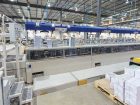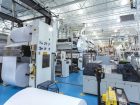
After new ownership was established in 2006, Marquis Book Printing of Montmagny, Quebec, has invested millions in acquisitions and new technologies to become one of Canada’s largest printers.
Marquis Book Printing over the past three years has more than doubled its annual revenue through consolidation, beginning in mid-2012 when the company, headquartered in Montmagny, Quebec, acquired two manufacturing plants from TC Transcontinental. The purchase of Transcontinental Gagné in Louiseville and Transcontinental Métrolitho in Sherbrooke added just over $35 million to Marquis’ revenue base, which was around $20 million before the purchase. The company’s employee count went from approximately 125 to 350 people.
Just over a year later, in late-2014, Marquis’ management team reaffirmed its confidence in the book-printing sector by acquiring certain assets of Imprimeur Lebonfon, a former Quebecor plant in northern Quebec, which included bringing over members of Lebonfon’s sales team who were generating about $10 million in business. Today, Marquis Book Printing is generating more than $60 million in annual revenue as one of Canada’s largest independent printing operations.
As Canada’s biggest monochrome printer, running six massive, highly automated Timson web presses in Louiseville, Marquis is also beginning to shift into more colour work to move with the book market. In October, the company’s future outlook for book manufacturing also materialized in an exclusive partnership with SoBooks of France to create a transatlantic technology bridge for on-demand book publishing. The most unique strategy currently being employed by Marquis, however, revolves around a yearlong project to build its own UV-enabled web-offset press, scheduled to start-up this December.
Printing platform
Maurice Marquis founded Marquis Imprimeur in 1937 and quickly began to focus on book-printing capacity after acquiring some rights from European publishers, because books were no longer being shipped overseas during World War II. He even built what was called the Bibliobus, travelling from town to town to sell books printed by Marquis. The company never lost sight of its core competency to manufacture books, a position that was embraced in 2006 through a management buyout by Serge Loubier, who now serves as President of Marquis, Pierre Fréchette, Vice President of Sales, and Marc Delisle, who remains involved as an advisor.
“Five years after the management buyout, we were where we said we were going to be,” says Loubier. “ Then we went all in with the [TC Transcontinental] deal. We pushed all of the chips into the middle.” At the time, Transcontinental, which was moving toward a marketing-services platform, was Marquis’ largest competitor in monochrome and two-colour book printing, which remains as the heart of its operation with newer investments like Canada’s first Variquick PC 15 press and an Oce’ Varioprint 6250. The Marquis platform has also been enhanced with a 10-colour Heidelberg (adding to four- and two-col0ur litho presses), a Xerox Versant and iGen150.
Over the past several years, Loubier has focused on annual capital expenditures of around $2.5 million to purposely build the platform and to support the more than $15 million invested in Marquis’ market consolidation strategy. Initially, Loubier explains the plan – as presented to the banks – was to shutdown the Louiseville plant acquired from TC, now called Marquis Gagné, and move assets to Montmagny to realize savings, but minds were quickly changed after spending time in the facility.
“The employees were like the gold out of the transaction that we made – a really good crew over there,” says Loubier, noting the plant is led by a relatively young workforce that was surprisingly bilingual, being based in a francophone region of Quebec. “The heart couldn’t live with the idea of closing [Louiseville] and we had also miscalculated the space needed to produce big runs of books… we didn’t have enough floor space, in my mind, in Montmagny.”
With a potential relocation to Montmagny, Loubier was concerned the skilled Timson operators and well-trained salespeople and CSRs from Louiseville might not join Marquis. This was the case when the Sherbrooke plant purchased from Transcontinental was closed, which also showed Marquis was ultimately going to do what was necessary to succeed in its consolidation plan. He worked with Louiseville’s union to settle on a 15 percent cut and a five-year contract, saving about $1 million per year in costs, and targeted opening up more business in the United States to support the plant.
At the time, Marquis was generating about $400,000 in business from the U.S. and the management team set an ambitious growth target to reach $4 million. “In the first year, we managed to bring in $5 million from the U.S.,” recalls Loubier, noting this was at a time when the Canadian dollar was at par with the U.S. greenback. “It has been three years since the deal and we are going to finish this year over $15 million [generated out of the U.S.].”
Loubier is now comfortable in stating that the consolidation plan has worked out well. In explaining its success, he points to the stability provided by the Montmagny plant and its unique Marquis Laurentien division based in Quebec City. Purchased about a year prior to the Transcontinental deal, Laurentien was the province’s largest producer of school agendas and number two (behind Marquis) in yearbooks. With the TC Metrolitho deal, Laurentien became number one in both categories.
The Laurentien division has about 40 employees focusing on the typesetting and graphic design of books, particularly in the educational sector, including working with more than 1,000 schools. Marquis is now growing its work with schools in other Canadian provinces and again focusing on expansion in the United States.
New opportunities
Largely based on the dollar advantage for Canadian exporters, and a stabilized book-printing market, following a few years of uncertainly around the potential impact of electronic publishing, Marquis is now shifting toward more organic growth for its printing platform. “For the next three to five years, our plan is to double that capital investment,” says Loubier, hinting this will likely point toward putting more sheetfed power into the platform, integrated finishing, and also new inkjet web press technology currently being investigated.
“We need [inkjet] technology that will accommodate monochrome with a click charge that we can then switch to a colour click charge,” says Loubier, noting Marquis’ unique need to maintain high-volume monochrome production as it looks to the future with colour. “I also want to be able to choose my paper, to change it, and I want to print like offset… I thought [press makers] would never achieve it, but they are starting to show me things.”
Loubier also remains intent on running what Marquis knows best – “a big press is hard to beat” – and the company’s vital litho systems are highly automated. “My average run at Marquis has to be 3,800 to 4,000, so my big concern is not the speed of the press when it is running. It is how long it is stopped for,” he says, describing a recent run of 1,500 books with 144 6 x 9-inch pages that took just under 15 minutes to print. “We have Timsons in Louiseville with zero makeready. We do not stop to change the plates.”
In the more immediate future, however, Loubier is eager to start up the web press invented by Marquis. The eight-month project has been led by Alain Roberge, former owner and Director of Lebonfon, because of his engineering background and years of experience in web-offset production. An outside firm provided schematics for the 16-page press as Marquis planned out its interior, including the integration of a brand new closed-loop colour control system. In November, the company was adding folders and preparing to take the press apart for moving and reinstalling in Louiseville.
“We wanted a press that would do four-colour without heatset. The ink will be dried by UV lamps, so there will be no emanation and no gas involved in the process. It is going to be the greenest colour web in Canada,” says Loubier. “I like machines, so building my own press was always a dream.”
Print this page


